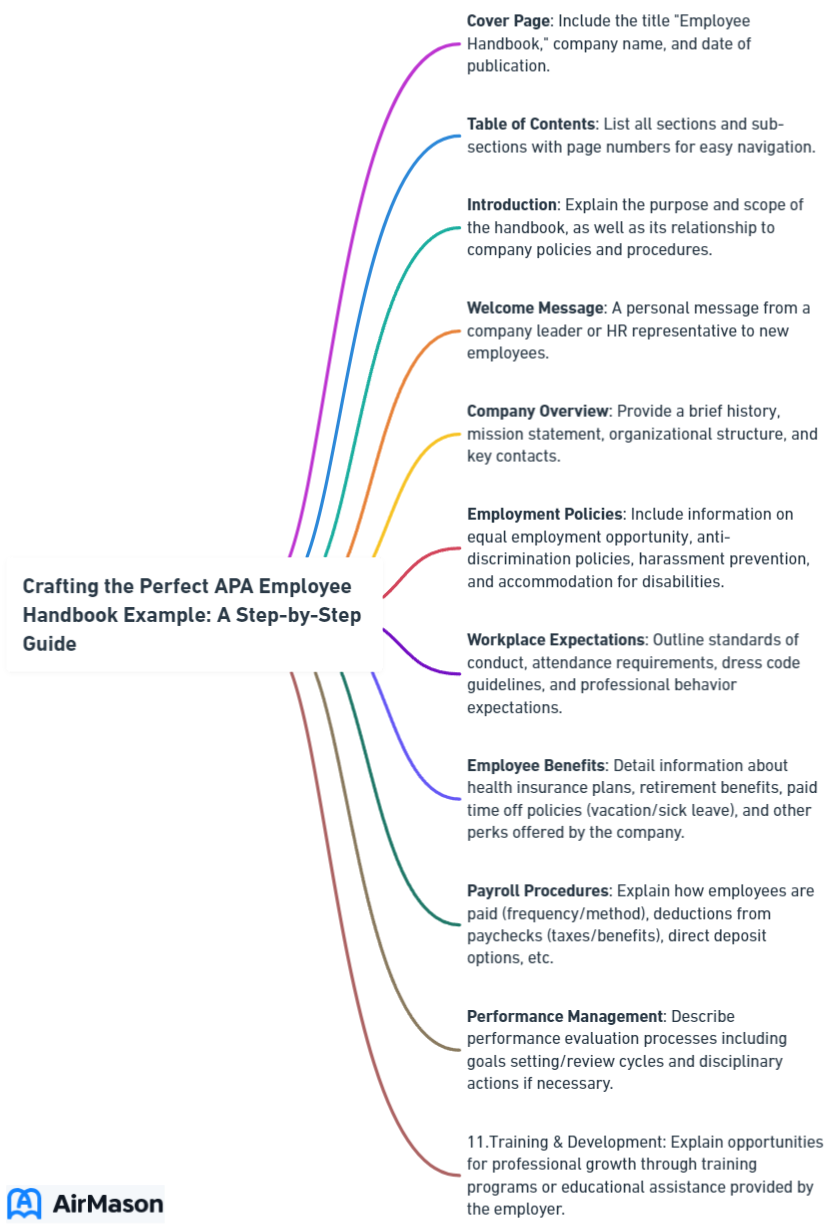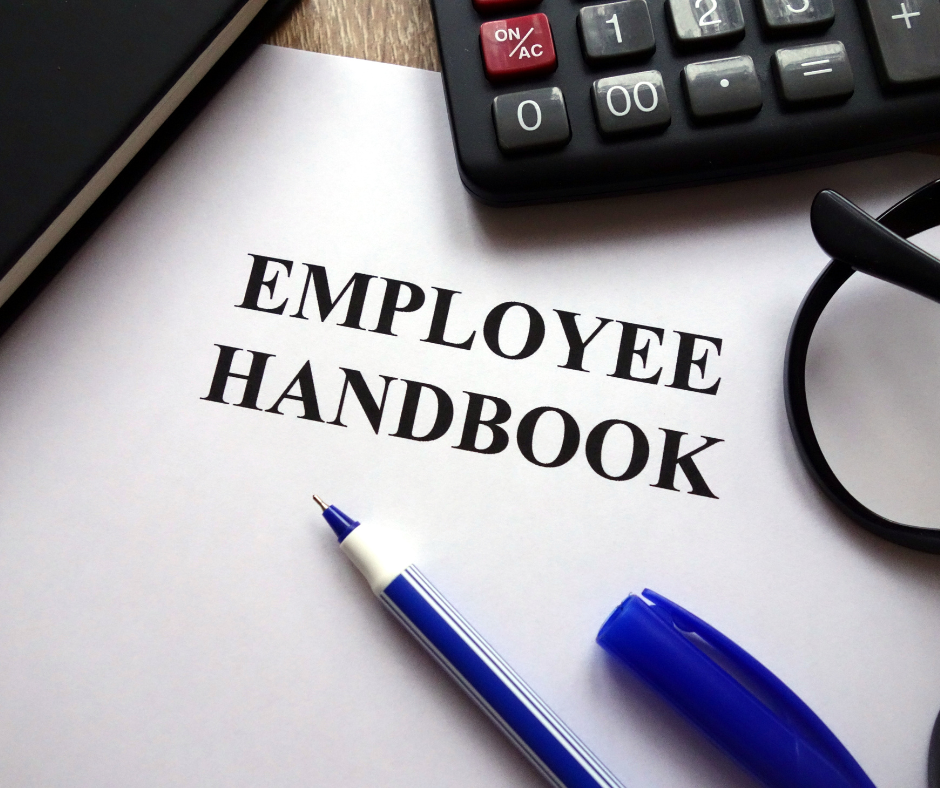
Are you seeking guidance on how to reference an employee handbook in APA format? Look no further. This article delivers a clear-cut method for crafting an APA employee handbook example, pinpointing the author, date, title, and publisher elements you’ll need. We provide the precise steps and examples to achieve an accurate citation, equipping you with everything necessary to master the APA style for your employee handbook.
Key Takeaways
- When citing an employee handbook in APA style, include author or organization, publication date, title, and publisher information.
- In-text citations for an employee handbook should include the organization name and publication year, with the provision for page numbers if citing a specific section.
- Employee handbooks are integral to business communication, especially for new employees, as they outline company policies, expectations, and culture.
Fortune 100 Company Employee Handbook
Welcome to the comprehensive and indispensable Fortune 100 Company Employee Handbook, a document designed to guide you through your journey within our esteemed organization. This handbook serves as your go-to resource for understanding our company’s values, policies, and expectations. Whether you’re a new hire or a seasoned team member, this handbook will provide you with valuable insights into the corporate culture, code of conduct, and various benefits available to you. We encourage you to familiarize yourself with the contents herein, as it plays a pivotal role in ensuring a harmonious and productive work environment for all. Your commitment to upholding the principles outlined in the Fortune 100 Company Employee Handbook is fundamental to our collective success.
Crafting an APA-Style Reference for Your Employee Handbook
Correctly citing resources in APA style involves a careful balance of key components. When it comes to employee handbooks, one must consider elements such as:
- The author or organizational author
- The publication date
- The title
- The publisher information
We will now delve deeper into each of these elements.
Identifying the Author or Organizational Author
The initial phase of constructing an unblemished APA citation for your employee handbook involves identifying the author. Typically, the author of an employee handbook is the organization itself rather than an individual. For instance, if you’re citing the General Motors employee handbook, General Motors would be the author. This rule applies even when a specific individual isn’t specified. So, if you’re citing a specific page, you’d include the page numbers in the in-text citation along with the organization’s name.
But what if there’s no identified author? In that case, APA guidelines recommend listing the organization as the author. For instance, if you’re citing a handbook from the Occupational Safety and Health Administration that contains a data set, your citation would start with “Occupational Safety and Health Administration” as the author. In your in-text citation, you’d use the full organization name in the initial citation, for instance (General Motors [GM], 2013), and subsequently use abbreviated citations when suitable, such as (GM, 2013).

Specifying the Publication Date
Another vital element in an APA citation is the date of publication. Whether you’re citing a print version or an online version of an employee handbook, the publication date should be included in full, formatted as YYYY, Month DD or YYYY, Season. But what if the publication date isn’t readily available? In such cases, the handbook is considered informally published, and the date of submission for publication, if available online, can be used instead.
In some instances, you may find a copyright year instead of a publication date. In such cases, APA guidelines recommend using the copyright year as the publication date. For example, an APA-style citation including the publication date would look something like this: General Motors. (2013). Employee handbook.
Title and Publisher Information
Upon determining the author and the publication date, the subsequent step is to address the title and publisher information. In an APA citation for an employee handbook, the title should be italicized, and the publisher’s information included. However, if the handbook is associated with a product or authored by a company, a different citation style should be utilized. For a product handbook or manual, such as a computer science textbook, the format typically includes the company name, product title, and publisher details.
But what about the publisher’s location? APA style no longer includes publisher locations in references for books and book chapters. Instead, the format should start with the name of the company, followed by the year of publication, and then the title of the publication. For example: General Motors. (2013). Employee handbook. The ‘Author’ should be replaced with the publisher’s name, as the company is already noted as the author. This ensures accurate attribution of the publication.
Liberty Media Employee Handbook Example
In the realm of corporate guidelines and workplace policies, the Liberty Media employee handbook serves as a noteworthy example. The Liberty Media employee handbook example offers a comprehensive approach to fostering a positive work environment, outlining the rights and responsibilities of employees. This handbook encapsulates the company’s commitment to transparency, fair practices, and employee well-being. Through the Liberty Media employee handbook example, the organization demonstrates its dedication to providing clear communication channels, setting expectations, and fostering a culture of mutual respect. This document stands as a testament to Liberty Media’s commitment to creating an inclusive and supportive workplace for its diverse workforce.
In-Text Citation Essentials for Employee Handbooks
Having explored the fundamentals of APA-style references for your employee handbook, we will now examine the intricacies of in-text citations. These are the citations that you include within the body of your text to refer readers to the full reference in your reference list.
In APA style, these apa citations typically include the author’s surname or organization name, the publication year, and, if applicable, the page number of the cited information.
First Citation in Text
Upon your initial citation of the employee handbook in your text, it becomes necessary to incorporate the author’s surname or the organization’s name, along with the publication year, within parentheses. For instance, an in-text citation for an employee handbook from General Motors published in 2013 would look like this: (General Motors, 2013).
But what if you’re citing a quote from the handbook? In that case, you’d need to include the page number as well. For example, if you’re quoting something from page 45 of the 2013 General Motors employee handbook, your in-text citation would look like this: (General Motors, 2013, p. 45). If there’s no individual author, you can use an organizational author as a substitute.
Subsequent Citations
Following the inaugural citation in your text, all ensuing citations of the identical source can be abbreviated. In APA style, you would only include the author’s last name and the year of publication, following the author-date method. But what about long author names or multiple authors? In these cases, APA guidelines advise using a shortened form of the name, or if there are multiple authors, listing only the first author’s name followed by ‘et al.’ in every subsequent citation.
The format for subsequent citations also depends on the number of authors. For works with one or two authors, all author names should be included in every citation. However, for works with three or more authors, only the first author’s name should be included followed by ‘et al.’ in every subsequent citation.
Formatting Examples: APA Employee Handbook Citations

Having established the foundation, we will now proceed to some hands-on examples. This next section will provide examples of APA-style citations for employee handbooks, both in the reference list and as in-text citations, to help reinforce the concepts we’ve discussed so far.
Example Reference List Entry
We will begin with a sample of an APA reference list entry for an employee handbook. The essential elements required for an APA-style references list entry are the author, date, title, and source. The full name of the group author is used, possibly with abbreviations in the text. A typical APA-style reference list entry for an employee handbook would look like this: General Motors. (2013). Employee handbook.
Remember, the title of the handbook should be written in sentence case and italicized. This example should give you a good idea of how to format your own reference list entries when citing employee handbooks in APA style.
Example In-Text Citation
Subsequently, we will examine a sample of an in-text citation for an employee handbook. In APA style, in-text citations typically include the company name and year, formatted as (Company Name, Year). So, if you were citing the 2013 General Motors employee handbook in your text, your in-text citation would look like this: (General Motors, 2013).
If your citation includes a quote from the handbook, you’d need to include the page number as well. For example, if you’re quoting something from page 45 of the 2013 General Motors employee handbook, your in-text citation would look like this: (General Motors, 2013, p. 45).
This example should help clarify how to format your in-text citations when citing employee handbooks in APA style.
Online and Print Versions: Citing Different Formats

Although the fundamentals of APA citation remain steady, minor variations occur when citing online and print versions of employee handbooks. The APA citation format for online and print versions of an employee handbook is generally similar, including the author, date, title, and source. However, when citing a web source, the URL should be included in place of the publisher’s information on the reference list.
So, how do you incorporate the URL into an APA citation for an online employee handbook? APA guidelines recommend including the company name as the author, the year of publication, the handbook title, and the URL.
For example, an APA citation for an online version of the 2013 General Motors employee handbook would look like this:
- Author: General Motors
- Year: 2013
- Title: Employee handbook
- URL: [URL]
Additional Considerations When Referencing Employee Handbooks
As is the case with any citation style, further factors always come into play. When citing company-specific documents like employee handbooks in APA style, challenges may include:
- Inconsistencies between in-text citations and the reference list
- Citing specific parts of a document such as page ranges or tables
- Identifying authors, especially when they are corporations or groups
For unpublished documents, it is recommended to use ‘[Unpublished manuscript]’ in the citation. For confidential documents permitted for citation, they should be treated as ‘Personal Communication’ and not included in the References page.
If the author of the employee handbook is unknown, APA style permits the use of the organization as the author. The citation format would then be: Organization Name. (Year). Title of Handbook. And when citing an employee handbook that has been updated multiple times, it’s recommended to use the name of the company as the author, the year of the most recent update, and the title of the handbook.
Adapting APA Guidelines for Company-Specific Documents
Occasionally, there might be a need to adjust APA guidelines to suit company-specific documents, like internal reports and training materials. For an internal company report, you’d list the company as the author and use (n.d.) if no date is available. The reference page format should start with the author, typically the company name.
When citing corporate training materials, you’d include the instructor’s last name and initials, the year the handout was created if known, and the title of the handout followed by [Class handout]. For online company-specific documents, you’d use the corporation or group name as the author, include the publication date, and provide the document title. If the document doesn’t have a title, a brief description should be included in brackets, and the citation should conclude with the URL of the document.
Unpublished material can be cited using one of the provided formats based on the specific situation.
The Role of Employee Handbooks in Business Communication
Employee handbooks function as more than just a citation resource, they hold a pivotal role in business communication. They serve to:
- Outline the company’s code of conduct, informing employees of acceptable behaviors and their rights
- Act as a deterrent against toxic behavior
- Promote healthier workplace attitudes.
Employee handbooks support effective business communication by furnishing employees with explicit work rules, policies, and crucial information, thereby ensuring consistent understanding throughout the organization. Moreover, they significantly influence company culture and employee expectations by cultivating a positive culture, establishing clear policies, and conveying the company’s mission, vision, and values to the employees.
Leveraging Employee Handbooks for New Employees
New employees, in particular, find immense value in employee handbooks. They:
- Reinforce the company’s vision and purpose
- Convey company policies and expectations
- Ensure uniformity
- Establish clear expectations
- Reduce ambiguity
- Welcome new employees, thereby aiding in their assimilation into the company culture and expectations.
Employee handbooks can facilitate the onboarding process for new hires by offering a comprehensive overview of:
- Company culture
- Work environment
- Company policies
- Other pertinent information
Including them as part of the preboarding package can assist new employees in acquainting themselves with the company before their start date.
The creation of a digital employee handbook can optimize the onboarding process, particularly for hourly employees, by offering a comprehensive company guide. These handbooks can be customized to accurately reflect the business and function as a valuable tool for new employees.
Qurate Retail Employee Handbook Example
In this illustrative Qurate Retail employee handbook example, we delve into the comprehensive guidelines and policies that shape the work environment at Qurate Retail. The “Qurate Retail employee handbook example” serves as a valuable resource for employees, providing insights into the company’s culture, expectations, and essential protocols. This handbook exemplifies Qurate Retail’s commitment to fostering a supportive workplace by addressing key aspects of employee engagement, professional conduct, and growth opportunities. From onboarding procedures to code of conduct, this example handbook encapsulates the essence of Qurate Retail’s dedication to creating a positive and thriving work environment.
Summary
In conclusion, crafting the perfect APA-style reference for your employee handbook doesn’t have to be a daunting task. Understanding the key components of APA citation, including author identification, publication date, and title/publisher information, sets the groundwork. From there, mastering in-text citations, handling different formats like online and print versions, and considering additional factors like company-specific documents and unique situations will ensure your citations are accurate and professional. Remember, clear and accurate citations not only uphold professional standards but also foster effective business communication, contributing to a healthy and informed workplace culture.
Frequently Asked Questions
How do you cite an employee handbook in APA format?
To cite an employee handbook in APA format, use the following format: Name of Company. (Year of publication). Title of publication. Location City, ST: Publisher of the handbook.
How do you format an employee handbook?
When formatting an employee handbook, include key sections such as Introduction & Welcome, Workplace commitments, Company Policies and Procedures, Employment Classification, Attendance Policies, Leave Policies, Work Performance, and Discipline Policy. Consider providing a brief history of the company and an introduction to company leadership in the welcome section to create a welcoming environment for new employees.
Important Disclaimer:
The article presented here does not serve as a representation of the company’s actual employee handbook mentioned in this article.
Our discussions and insights regarding employee handbook are based on assumptions about what may be considered significant in the companies’ policies. These assumptions are drawn from available information and industry knowledge. Readers are advised that the content provided is for informational purposes only and should not be construed as an exact reflection of any company’s official policies or procedures. For precise and accurate details regarding a company’s employee handbook, individuals should refer directly to the company’s official documentation or consult with appropriate representatives.
Please be aware that the content on this page has been generated by using artificial intelligence language models and may contain errors, inconsistencies, or outdated information. It is provided as-is without any warranties or guarantees of accuracy. We strongly recommend using this content as a starting point for further research. We disclaim any liability for damages or losses resulting from the use or reliance on this content.